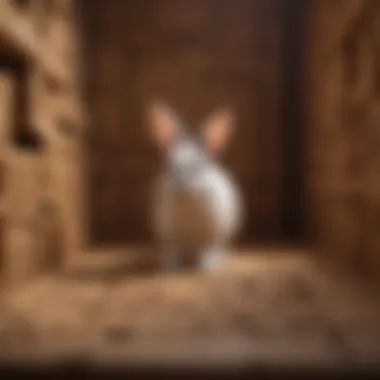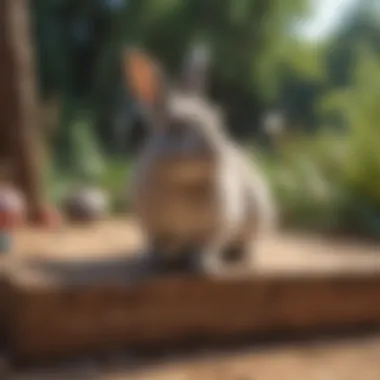Games for Rabbits: Playful Activities for Well-Being


Intro
Rabbits are often underestimated as pets. Many people see them as simple creatures, but they have nuanced needs and personalities. Understanding these aspects is crucial for any pet owner who wants to provide a nurturing environment. When considering how to enhance a rabbit's life, engaging in specific games and activities is one effective solution. This article provides insights into selecting games that align with a rabbit's natural instincts, enhancing both their mental and physical health.
Understanding Your Pet
Pet Behavior Basics
To enrich a rabbit's play life, it is fundamental to comprehend their natural behavior. Rabbits are prey animals and possess instincts that dictate their actions. They thrive in environments where they can explore, dig, and hide. Observing your pet's behavior helps in identifying what games might appeal to them. Providing a mix of activities is essential. This not only prevents boredom but also encourages physical exercise.
Common Breed Characteristics
Different breeds come with unique traits. For example, Mini Rexes tend to be more inquisitive, while Holland Lops may favor a laid-back environment. Understanding these distinctions aids in tailoring games suitable for each breed. This customization enhances their engagement and enjoyment, promoting better mental health.
Species-Specific Needs
Rabbits are social animals, and they benefit from companionship, either from other rabbits or interacting with humans. Games should consider their need for social involvement, allowing them to bond with their playmates. This aspect of play will enhance their emotional well-being.
Enrichment and Activities
Indoor vs. Outdoor Activities
Choosing between indoor and outdoor games depends heavily on your living situation. Indoor play can consist of safe spaces where rabbits can run and explore. Corners with tunnels, boxes, or climbing structures can stimulate their curiosity. Outdoor activities offer a chance for natural instincts to surface, as they can dig, jump, and graze in a controlled area. Ensure any outdoor play is supervised to maintain safety.
Interactive Toys and Games
Interactive toys are crucial in rabbit play. They can involve simple objects like cardboard boxes or more complex puzzle toys that dispense treats. Such toys not only keep rabbits entertained but also challenge their problem-solving skills. When rabbits figure out how to access their rewards, it provides cognitive stimulation.
Socialization Opportunities
Incorporating socialization into playtime is vital. Bonding activities can be as simple as sitting with your rabbit, allowing them to explore. This helps build trust and enhances the relationship between pet and owner. Group playdates with other rabbits can also encourage playful interactions and reduce loneliness.
"Enriching a rabbit's life through games is not just about fun; it's about fostering a deeper bond and understanding their needs."
Closure
Selecting the right games for rabbits extends beyond mere entertainment. It enriches their lives, fulfilling both mental and physical requirements. Understanding their behavioral traits and needs will enhance the gaming experience. By creating stimulating environments and interactive games, pet owners can elevate the quality of life for their rabbits significantly.
The Importance of Play for Rabbits
Play is a fundamental aspect of a rabbit's well-being. It contributes greatly to their physical health and mental stimulation. Engaging in play helps rabbits express their natural behaviors and instincts. Understanding these aspects is crucial for pet owners who wish to enhance their rabbits' quality of life through appropriate games and activities.
Understanding Rabbit Behavior
Rabbits are prey animals, and their natural instinct is to explore and interact with their environment. They are curious creatures that enjoy hopping, digging, and chewing. When rabbits play, they mimic behaviors they would perform in the wild. This involves a mixture of running, hiding, and investigating different objects. Understanding these behaviors is essential when selecting games for your rabbit. For instance, offering toys that encourage digging can satisfy their instinctual behaviors.
Another crucial insight into rabbit behavior is their social nature. Some rabbits thrive on interaction with their human companions or other rabbits. Playtime can help them socialize and reduce feelings of loneliness. Observing how a rabbit responds to various stimuli helps in determining preferred types of play, which enhances their happiness.
Benefits of Games for Rabbits
Incorporating games into a rabbit's routine has various advantages:
- Physical Exercise: Just like humans, rabbits need regular exercise to maintain a healthy weight and prevent obesity. Games that involve running or jumping promote cardiovascular health.
- Mental Stimulation: Engaging games, such as puzzle toys, challenge a rabbit’s intellect. Mental stimulation helps prevent boredom, which is essential for emotional well-being.
- Stress Relief: Playing can be a great way to alleviate stress. Games help them let off steam, leading to a relaxed and happy pet.
- Bonding Experience: Playtime provides a unique opportunity for the pet owner to bond with the rabbit. This relationship can lead to a more trusting and affectionate pet.


Engaging in play not only meets physical needs but also addresses mental and emotional aspects of a rabbit's life. This multifaceted approach to rabbit care can prevent behavioral problems, promote health, and enhance overall happiness.
"Play is vital for a rabbit's health and happiness, transforming their daily life into an enriching and enjoyable experience."
Overall, the importance of play for rabbits cannot be overstated. Understanding their behavior and the benefits of games will guide pet owners in creating a joyful and fulfilling environment.
Types of Games Suitable for Rabbits
Understanding the types of games suitable for rabbits is vital for their development and well-being. Rabbits are naturally curious and playful animals, and engaging them in diverse games can significantly enhance both their physical and mental health. Different types of games address various aspects of a rabbit's nature, from their need for physical activity to their instinct to explore and forage. Through play, rabbits can express behaviors that are essential for their happiness, leading to more fulfilled lives and stronger bonds with their human companions.
Physical Games
Physical games are essential for the health of rabbits. These activities promote fitness and allow rabbits to utilize their natural agility and energy. They can help maintain healthy weight, support cardiovascular health, and prevent boredom. Here are some notable physical games:
Obstacle Courses
Obstacle courses are an excellent way to combine fun and exercise. These setups consist of barriers and tunnels for rabbits to navigate. This game stimulates a rabbit’s natural leaping and jumping behaviors. The key characteristic of obstacle courses is that they challenge a rabbit’s agility and confidence. They are popular among pet owners because they encourage creativity in game design. The unique feature is the versatility; owners can change the course layout frequently, keeping the experience fresh. However, the downside can be the space requirements, as it may not be practical in small living areas.
Chasing Games
Chasing games can involve either the rabbit chasing a toy or another rabbit. This type of game taps into the natural instincts of rabbits, as they often enjoy darting around. The key aspect of chasing games is that they combine exercise with social interaction. They are beneficial because they can improve a rabbit's reflexes and speed. What makes this game unique is the excitement it brings; chasing stimulates adrenaline and encourages active behavior. On the other side, there must be careful supervision to avoid any potential aggression.
Tunnels
Tunnels offer rabbits an engaging way to explore their environment. Rabbits love to tunnel as it is an innate behavior. Key characteristic of tunnels is their ability to provide a safe space for rabbits to play and hide. They are beneficial because they can enhance a rabbit's sense of security while providing them with the opportunity to exercise. A unique feature is how easy they are to set up and include in various games. The disadvantage might be that some rabbits may show initial fear of entering tunnels, requiring gradual introduction to build comfort.
Mental Stimulation Games
Mental stimulation games are equally significant. These activities encourage cognitive engagement and problem-solving skills. Stimulating the mind is as crucial as physical exercise. Here are several games targeted at mental stimulation:
Puzzle Toys
Puzzle toys incorporate challenges that require rabbits to work for their food or treats. This type of game promotes critical thinking and can reduce boredom. The key characteristic of puzzle toys is their design, which often includes mazes or compartments for treats. They are beneficial because they enhance problem-solving skills and keep a rabbit engaged for extended periods. The unique feature is the variety available, ranging from simple to complex puzzles. However, some pets might find them too challenging at first, which can lead to frustration.
Hide-and-Seek
Hide-and-seek is a fun game that involves a rabbit looking for hidden treats or toys. This activity taps into their foraging instincts, making it enjoyable and rewarding. The key aspect is the thrill of discovery, as rabbits love to explore and uncover hidden items. It is beneficial because it encourages natural scavenging behavior. The unique feature is the need for minimal resources, as you can use items around the house. A potential downside is that some rabbits do not engage actively unless specially motivated.
Foraging Games
Foraging games involve scattering food around a designated area, encouraging rabbits to search for their meal. This supports their natural behavior of searching for food in the wild. The key characteristic of foraging games is the emphasis on mental and physical engagement. It is beneficial as it satisfies a rabbit's instinctual drives. The unique feature is its adaptability, as you can change the hiding spots regularly. The downside may be that it requires time and consistency to see improved foraging skills.
Social Interaction Games
Social interaction games are also critical for rabbits. Rabbits are social animals by nature and benefit from interaction with others. These games promote bonding and social skills. The following types can enrich a rabbit's social experience:
Playdates with Other Rabbits
Organizing playdates with other rabbits is an excellent way to provide social enrichment. These encounters enable rabbits to interact and learn from each other. The key characteristic is the opportunity for socialization, which is vital for a rabbit's psychological health. They are beneficial because they help reduce loneliness and isolation. The unique feature is that they can foster peaceful relationships and instinctual behaviors. However, not all rabbits are compatible, so introductions should be gradual and supervised to ensure safety.
Training Sessions
Training sessions involve teaching rabbits commands or tricks using positive reinforcement. This interaction is beneficial as it further builds the bond between a rabbit and its owner. The key characteristic of training sessions is their focus on communication and engagement. They are beneficial because they enhance mental stimulation and focus. The unique feature is the measurable progress that pet owners can observe. One potential disadvantage is that some rabbits may take longer to learn, requiring patience and understanding from the owner.
Creating an Engaging Play Environment


Creating an engaging play environment for rabbits is essential not only for their entertainment but also for their overall health. A thoughtfully designed play space stimulates their natural instincts and encourages exploratory behavior. When rabbits are presented with engaging environments, they tend to exhibit less stress, which can lead to improved physical and emotional well-being. Moreover, these environments can help in honing their skills, from digging to jumping, which are intrinsic to their nature.
Selecting the Right Space
Choosing the right space for rabbit play is crucial. Ideally, it should be spacious, allowing rabbits to hop freely and explore without feeling restricted. Open areas, such as a fluffy room or a safe backyard, can be great options. However, ensure that the space is free from hazards like sharp objects or toxic plants. It’s beneficial to create a designated play area that can be easily monitored. This helps in observing their behavior and ensuring their safety during playtime.
Safety Considerations
Safety must always come first when designing a play environment for rabbits. Check for any items that pose risks, such as electrical cords or small objects that can be swallowed. Ensure that the flooring is safe; hard surfaces might be uncomfortable, while slippery surfaces may cause accidents. Use non-toxic materials for toys and enclosures. Additionally, keep environmental factors in check. Excessive heat or cold can impact a rabbit's comfort level. Always provide a calm, secure environment where rabbits can feel relaxed while they play.
Introducing New Toys
New toys can drastically alter the dynamics of playtime. When introducing new toys, it’s important to do so gradually. Start with a few simple items, and observe your rabbit's reaction. Toys that mimic natural behaviors, such as chewing and digging, will likely be well received. Rotate toys regularly to maintain interest. This practice not only keeps the environment fresh but also encourages mental engagement. Ensure toys are safe and suitable for your rabbit’s age and size.
Engaging play environments lead to healthier, happier rabbits. It’s essential to invest time in creating a safe and stimulating area for them.
The Role of Observation in Play
Observation is a critical element when understanding how to engage rabbits through play. By closely monitoring their interactions with games, owners can identify what activities resonate best with their pets. This not only improves the quality of playtime but also contributes to the overall well-being of the rabbit. Each rabbit is unique. Their preferences can vary based on temperament, background, and socialization. Thus, keen observation can unveil these preferences.
One of the primary benefits of observation is that it allows owners to recognize what excites or calms their rabbits. Some may prefer active games, while others might enjoy more subdued interactions. By noting these tendencies, owners can tailor activities to better suit their rabbits' personalities. This customization fosters a deeper bond between owner and pet, enhancing the quality of time spent together.
Moreover, understanding these behaviors can help prevent stress or anxiety during play. A rabbit that is overwhelmed or bored may express signs of discomfort. Recognizing these signals can lead to quicker adjustments in activities, ensuring that playtime remains positive.
"Observation is not just about watching; it’s about understanding the behaviors and emotions of your rabbit."
In this sense, observation serves as the foundation for an enriching play environment. Careful watching provides insights into the rabbit's mood and level of engagement, making it possible to implement more effective and enjoyable experiences.
Recognizing Preferences
Recognizing what your rabbit enjoys is the next step. This requires attentiveness to how they engage with various toys and activities. Take note of which toys they prefer and how they interact with them. Do they show interest by nudging, chewing, or hopping around? These behavioral cues indicate preference.
You can create a simple checklist to monitor your rabbit’s reactions:
- Toys Played With Most: List each item and see which ones are chosen frequently.
- Physical Responses: Observe if they hop excitedly, become distracted, or seem indifferent.
- Duration of Play: Track how long they engage with each type of game or toy.
By compiling this data, you can gain a clearer understanding of your rabbit’s likes and dislikes.
Adapting Games to Individual Needs
Once you have recognized the preferences of your rabbit, the next task involves adapting games to suit their individual requirements. This is very important because not all rabbits will react the same way to a given game. For instance, while some may love agility courses, others might feel intimidated or uninterested.
Adapting games can involve modifications or introducing new elements. Here are a few suggestions:
- Adjusting Pace: For a more cautious rabbit, create slower-paced games. Use gentle movements to introduce them gradually to new challenges.
- Playing with Size: Smaller rabbits may need smaller toys or spaces to navigate, while larger breeds might enjoy more expansive areas.
- Incorporating Preferences: If a rabbit shows particular interest in hiding or burrowing, utilize soft bedding or boxes that encourage these natural instincts.
In this way, adapting games ensures that the playtime meets the specific needs of each rabbit, leading to a more fulfilling and enjoyable experience.
Making Games Versatile and Fun
Play for rabbits is not just about letting them run around. It is about making their experiences stimulating and enjoyable. Versatile games allow rabbits to engage physically and mentally. When games are versatile, they can appeal to a broad range of preferences and energy levels. This adaptability enhances the rabbit's quality of life. It also ensures that playtime never becomes monotonous.
Switching Up Activities
Changing activities frequently keeps a rabbit engaged. Rabbits can quickly lose interest if the same game is played too often. Rotating games can help in maintaining their enthusiasm. This can be achieved by introducing new toys, rearranging the play area, or changing the structure of games.


- Introduce New Toys: Incorporate various types of toys that encourage different play styles. For instance, toys with squeaks or crinkles can attract attention.
- Rearranging the Play Area: Changing the layout can stimulate curiosity. Rabbits love exploring new environments.
- Seasonal Activities: Adapt games to reflect the seasons. In better weather, outdoor play can be stimulating. When indoors, create a cozy play corner filled with engaging items.
By switching up activities, pet owners can prevent boredom and promote active engagement. A continuous flow of new experiences can lead to happier and healthier rabbits.
Incorporating Natural Instincts
Understanding a rabbit's natural instincts is vital in making play enjoyable. Rabbits are naturally curious, social, and playful animals. Incorporating activities that align with these instincts can make games more engaging.
- Foraging Games: Create games where rabbits can dig or search for treats hidden in bedding or boxes. This taps into their natural instinct to forage for food.
- Chasing and Hiding: Many rabbits enjoy a game of hide and seek. This can be accomplished by hiding behind furniture or toys, encouraging the rabbit to find you.
- Social Play: Creating playdates with other rabbits can satisfy their social needs. Rabbits are social animals, and they thrive in the company of others.
By recognizing and utilizing these natural instincts, owners can craft a rich play environment.
Engaging in versatile play not only enhances physical health but also nurtures a rabbit's mental well-being.
A combination of switching activities and incorporating natural instincts allows pet owners to design games that enhance the overall joy of their rabbit's life. The right balance of variation and instinctual play creates a fulfilling and stimulating environment.
Monitoring and Evaluating Playtime
Monitoring and evaluating playtime are crucial aspects of ensuring that games and activities truly benefit rabbits. By closely observing your rabbit during play, you can gain insights into what engages them most and how they react to different stimuli. This not only enriches their experience but also allows for adjustments that cater to their individual needs. After all, play isn't just a fun component of their daily routine; it plays a significant role in their overall well-being.
Effective monitoring helps you assess the level of engagement during play sessions. Engaged rabbits display energetic behavior, such as hopping, exploring, and interacting with toys. If a rabbit appears indifferent or disinterested, it may indicate that the chosen activity is not appealing. Therefore, realizing their interests can guide you to select games that ignite their curiosity and excitement.
Additionally, evaluating their playtime offers an opportunity to observe changes in behavior over time. These observations can reveal patterns, supporting you in adjusting the complexity or type of games. A responsive approach to playtime enriches the rabbit's quality of life, creating an environment that meets their evolving preferences.
Tracking Rabbit's Engagement
To effectively track engagement, it is necessary to observe specific behaviors during play. Key indicators of engagement can include:
- Active exploration: This involves the rabbit investigating new toys or areas.
- Social interaction: If playtime includes other rabbits, notice how they interact.
- Vocalization: Some rabbits express excitement through sounds.
- Body language: Ears up and continuous hopping indicate positive engagement.
Keeping a journal can be helpful. Documenting activities alongside your rabbit’s reaction will clarify which games yield the best results. Use this information to rotate activities, keeping the play experience fresh and stimulating.
Identifying Stress or Discomfort
It is equally important to watch for signs of stress or discomfort. While most rabbits enjoy play, not all activities suit every individual. Signs of stress may manifest as:
- Hiding or retreating: A rabbit may withdraw if feeling overwhelmed.
- Thumping: This behavior can indicate a sense of danger or discomfort.
- Nip or bite: If a rabbit is in distress, they may react negatively.
- Loss of interest: If the rabbit stops engaging entirely, they may not be comfortable.
Recognizing these signals allows for a critical adjustment in your approach to playtime. Fostering a safe and enjoyable atmosphere should be your top priority. It may mean modifying the environment or altering the games being played. Listening to your rabbit's cues ensures that playtime remains a positive and fulfilling experience.
Ending: Fostering a Playful Environment
Creating a playful environment is essential for enhancing the quality of life for rabbits. Play is not merely a leisure activity; it is a fundamental aspect of a rabbit's well-being that supports both their mental and physical health. By prioritizing play, you nurture a rabbit’s inherent instincts and promote a balanced lifestyle.
An engaging play environment provides rabbits with the opportunity to explore, exercise, and keep their minds stimulated. Rabbits are naturally curious creatures, and if they do not have sufficient play options, they may become bored or develop negative behaviors. Therefore, it is critical for pet owners to recognize the significance of integrating structured play activities into their daily routines.
Key Elements of a Playful Environment
- Variety of Games: Introduce a range of activities that stimulate both physical and mental engagement. Options like obstacle courses, puzzle toys, and interaction with other rabbits can significantly enhance their playtime.
- Safe Space: Ensure the play area is secure and free from hazards. A well-designed environment mitigates risks and allows for more active and free movement, which is important for a rabbit's health.
- Regular Routine: Consistency is vital. Incorporate playtime into daily habits so that rabbits can anticipate and enjoy these moments. Just like humans, they thrive on a structure that allows for time to unwind and play.
"A well-fostered play environment not only provides enjoyment but also contributes to a rabbit’s overall happiness and health."
Benefits of Encouraging Play
By fostering an engaging play environment, you can expect several benefits:
- Increased physical activity, leading to better overall health
- Reduced likelihood of behavioral issues stemming from boredom or stress
- Enhanced mental stimulation through varied activities that challenge their intellect
- Stronger bonds between the rabbit and family members as interactions during play deepen relationships
Considerations for Pet Owners
While focusing on enhancing your rabbit's play environment, it is important to remain observant. Each rabbit has unique preferences and needs; therefore, adapt the activities according to individual behavior. Monitor their engagement during playtime, and be ready to modify games that don't seem to hold their interest. An adaptable approach ensures that play remains a positive experience rather than a routine obligation. Developing an understanding of your rabbit’s likes and dislikes will deepen your bond and ensure a vibrant and happy rabbit life.







